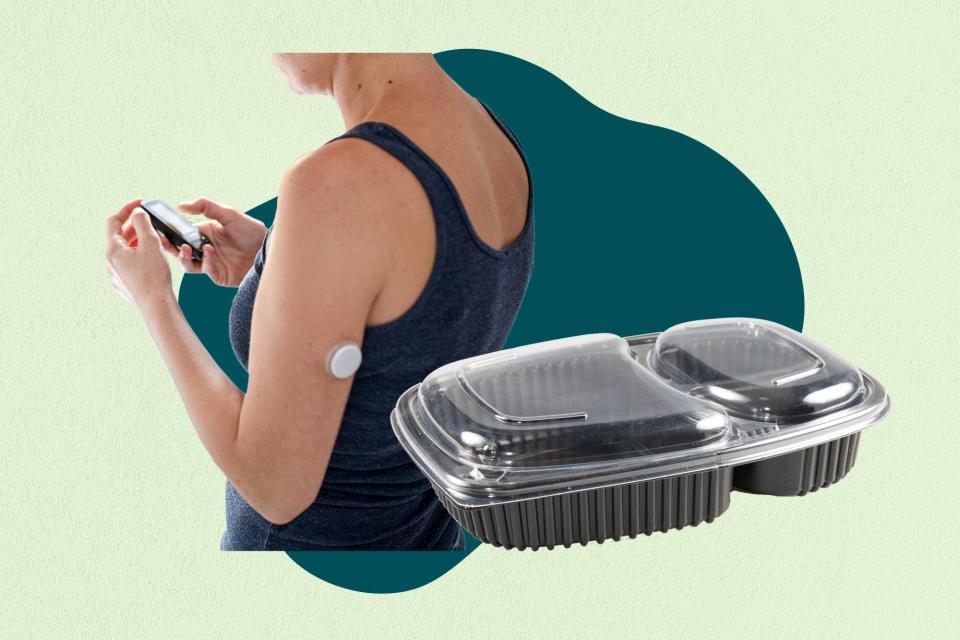Exposure to High Levels of Plastic Compounds May Increase Diabetes Risk by 63%, New Study Finds
Although you might not realize it, plastic permeates our lives in many more ways than just those disposable drink straws. Plastic is in the packaging for our foods and drinks, in some clothing products, in personal care products and even our drinking water by way of microplastics.
As you might guess based on that list, they're pretty hard to completely avoid—and in terms of your health, you probably don't need to fret too much about them all. Some types of plastic are FDA-approved and generally recognized as safe. Other plastics, though, may be more harmful to human health. Case in point: Phthalates, a chemical added to some plastics to make it more flexible. A January 2022 study in Environmental International reported that phthalate exposure might be linked to increased likelihood for developing allergies, endocrine or reproductive issues, weight challenges and more.
This week, we're learning that this specific type of plastic might present another potential health harm. Women exposed to high levels of phthalates may have an up to 63% increased risk of developing type 2 diabetes, according to a February 8, 2023 study published in The Journal of Clinical Endocrinology & Metabolism.
Read on to learn more about this new research, plus what details to look for on a product's packaging to determine if it includes phthalates.

Getty Images
What This Diabetes Study Found
To reach this conclusion, scientists at the University of Michigan School of Public Health analyzed 6 years of data from 1,308 women between age 42 and 52 enrolled in the Study of Women's Health Across the Nation. The subjects included white, Black, Chinese, Japanese and Hispanic individuals. When they signed up between 1996 and 1997, none of the women had taken any exogenous reproductive hormones (like birth control pills or hormone replacement therapy) in the previous 3 months.
At the start of the program, and in 2002 or 2003, the researchers asked for urine samples in PET (polyethylene terephthalate) tubes, which have been proven not to release phthalates when stored at cold temperatures. They froze the samples until 2017 and 2018, when they used mass spectroscopy to measure the levels of 12 different phthalates and phthalate metabolites in each of the urine samples, a common test used to estimate phthalate exposure.
Throughout the course of the study, the participants had nine follow-up visits to check in with the scientists about whether they had been diagnosed with type 2 diabetes or were prescribed antidiabetic medication. The women also were given a fasting blood glucose test; those who had greater than 126 milligrams per deciliter (mg/dL) for two consecutive visits were classified as having type 2 diabetes. (This fasting blood glucose level is the same diagnostic criteria the American Diabetes Association uses.)
Related: 5 Habits to Add to Your Day to Prevent Prediabetes—And 3 to Avoid, According to Dietitians
During the course of the study, 4.7%, or 61 of the participants, developed diabetes. The urine samples showed that, compared to their peers who didn't develop diabetes, the women with diabetes had significantly higher concentrations of all of the measured phthalate metabolites except for two. As a cohort, the women who were exposed to higher levels of phthalates appeared to have up to 63% increased risk of developing type 2 diabetes, the scientists confirm.
However, when you break down the data further, the link between phthalate metabolite exposure and diabetes was only found among white women, not women who identified as Black or Asian. (The paper's authors say, it's "unclear what might explain such racial/ethnic differences".) The association was especially strong for white women who met the BMI criteria for having overweight or obesity at the start of the study.
Related: Is BMI a Good Indicator of Your Overall Health? Here's What the Research Says
Earlier research has shown that phthalates may impact insulin, an important hormone involved in blood sugar regulation, and that's what the scientists involved in this new study believe might be occurring among their study participants.
The Bottom Line
A new study about type 2 diabetes in women found that high phthalate exposure might increase risk for developing the blood sugar-related metabolic condition later in life. While this study can't definitively prove that phthalates cause diabetes, it does open the door to the possibility of a connection.
Since the follow-up time and sample size of the study was fairly small, and the scientists weren't able to measure exposure to phthalates more than just at the time of the urine samples, more research is needed to confirm these results. Still, it certainly can't hurt to try to limit exposure to phthalates when possible.
The CDC and Envionmental Protection Agency (EPA) report that phthalates are hiding out in hundreds of commercial products, including some vinyl flooring, construction materials, electric wiring, lubricating oils, soaps, shampoos, hairsprays, other forms of plastic packaging, garden hoses and tubes used for medical purposes.
According to the National Institutes of Health, the 8 most commonly-used phthalate compounds include:
BBP: butyl benzyl phthalate (LMW)
DBP: di-n-butyl phthalate (LMW)
DEHP: di-(2-ethylhexyl) phthalate (HMW)
DEP: diethyl phthalate (LMW)
DiDP: di-isodecyl phthalate (HMW)
DiNP: di-isononyll phthalate (HMW)
DnHP: di-n- hexyl phthalate
DnOP: di-n-octyl phthalate (LMW)
Since this information might not be listed on the packaging, a good rule of thumb is to look for the number "3" inside, and the letters "V" or "PVC" below, the triangle-shaped arrow recycling symbol that's often molded into the plastic on the bottom of the product.
Up Next: 8 Simple Ways to Cut Back on Plastic in Your Food and at Home

